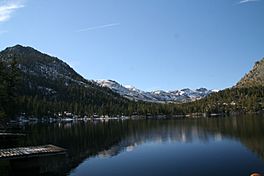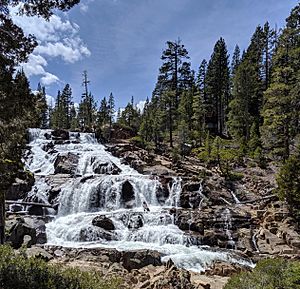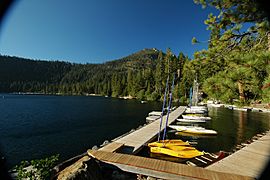Fallen Leaf Lake facts for kids
Quick facts for kids Fallen Leaf Lake |
|
|---|---|

Fallen Leaf Lake in winter
|
|
| Location | El Dorado County, California |
| Coordinates | 38°55′N 120°04′W / 38.92°N 120.06°W |
| Primary inflows | Glen Alpine Creek |
| Primary outflows | Taylor Creek |
| Basin countries | United States |
| Max. length | 2.9 mi (5 km) |
| Max. width | 1.0 mi (1.6 km) |
| Max. depth | 415 ft (126 m) |
| Surface elevation | 6,377 ft (1,944 m) |
Fallen Leaf Lake is a beautiful mountain lake in El Dorado County, California. It is located very close to the California–Nevada border. This lake is about one mile southwest of the much bigger Lake Tahoe.
Fallen Leaf Lake is shaped like an oval and runs from north to south. It is about 2.9 miles (4.6 km) long and 0.9 miles (1.4 km) wide. This lake was formed by at least two huge sheets of ice called glaciers. These glaciers moved down the Glen Alpine Valley a long time ago. If the glaciers had kept going, Fallen Leaf Lake might have become part of Lake Tahoe. You can still see a pile of rocks and dirt left by a glacier at the north end of the lake.
Contents
What's Around Fallen Leaf Lake?
Fallen Leaf Lake is inside lands managed by the U.S. Forest Service. This area is part of the Lake Tahoe Basin Management Unit. The land around the lake is a mix of private property and land leased from the Forest Service. This creates a checkerboard pattern of different land types.
How to Get to Fallen Leaf Lake
You can reach Fallen Leaf Lake by taking Fallen Leaf Road. This road is about 5 miles (8 km) long. It starts from State Route 89, which runs along the south shore of Lake Tahoe. The road is one lane wide in some spots, with special areas for cars to pass each other.
As you drive along Fallen Leaf Road, you will pass the Fallen Leaf Lake Campground. This campground is run by the Forest Service. You will also see private homes and beautiful meadows. Near the lake, there is a small marina and store. You can also find St. Francis of the Mountains, which is an old Episcopalian chapel.
Other roads, like Angora Road and Cathedral Road, also lead to different parts of the lake. Some homes on the west side of the lake do not have road access. People get to these homes by walking or using a boat.
Water Flow: In and Out
Most of the water in Fallen Leaf Lake comes from Glen Alpine Creek. This creek flows into the south end of the lake. Glen Alpine Creek gets its water from several smaller lakes in the Desolation Wilderness area. In the spring, melting snow makes the creek flow very strongly. As summer goes on, the water flow slows down.
Taylor Creek is the only place where water leaves Fallen Leaf Lake. There is a low concrete dam that helps control how much water flows out. This dam is 12 feet (3.7 m) high and 265 feet (81 m) long. Taylor Creek flows north from the lake and eventually reaches Lake Tahoe.
About the Lake's Water
Fallen Leaf Lake is about 415 feet (125 m) deep at its deepest point. This deep spot is near Mount Tallac. The average depth of the lake is around 240 feet (72 m). Near the northern end, the lake bottom slopes gently. You can often see the bottom from the surface for a good distance. Along other parts of the shore, the water gets deep very quickly.
The water in Fallen Leaf Lake is very clean. This is because there isn't much big business around the lake. Also, modern ways of handling waste and preventing dirt from washing into the lake help keep it clean. You can usually see about 40–50 feet (10–15 m) down into the water. The water is also safe to drink. Many homes by the lake have pipes that bring water directly from the lake.
The water in Fallen Leaf Lake completely changes every eight years. This is much faster than Lake Tahoe, where the water takes about 700 years to fully change. The surface of Fallen Leaf Lake is 152 feet (46 m) higher than Lake Tahoe.
Scientists have found very old conifer trees at the bottom of Fallen Leaf Lake. These trees have been preserved by the cold water for about 800 years. Some scientists think these trees grew during a very dry period, called a "megadrought", between the 9th and 12th centuries. Other scientists believe the trees slid into the lake during earthquakes.
In the late 1990s, a rule was made to ban certain types of boat engines. This helped to stop pollution from those engines in the lake.
Mountains and Trails
When the glaciers left the Fallen Leaf area, they created amazing rock shapes. These include Cathedral Peak to the west and the ridge where Angora Lookout is located to the east. Cathedral Peak is about 8,200 feet (2,500 m) tall. It looks like a single peak from the lake, but it's actually the start of a ridge.
There isn't a direct trail to Cathedral Peak. However, you can reach it by hiking on other trails. One trail, called the Middle Trail to Tallac, starts near Lily Lake. Another trail, the Lake Trail, begins at the end of Fallen Leaf Road. It slowly climbs up to Cathedral Lake and Floating Island Lake. These trails eventually connect to the Mount Tallac trail. Mount Tallac is a very tall mountain, about 9,735 feet (2,967 m) high.
Lake Life: Fish and Wildlife
The Lahontan cutthroat trout is a type of fish that naturally lives in Fallen Leaf Lake. However, other types of fish were brought into the lake, and they caused problems for the native trout. Efforts began in 2006 to bring the Lahontan cutthroat trout back to Fallen Leaf Lake. Even though these trout face challenges from other fish, their numbers are slowly growing.
Fun Water Activities
Many homes along the lake have docks or boathouses. People often have ski boats or small sailboats. The marina at the lake can hold about 60 boats. Wakeboarding and Water skiing are very popular activities. People also enjoy fishing, kayaking, and rowing.
Fishing is a popular activity, even if it's not always easy to catch fish. You might find brown trout, rainbow trout, and lake trout. The Forest Service adds fish to the lake and Glen Alpine Creek to help anglers. The return of the Lahontan cutthroat trout has also been a success.
Sailing on Fallen Leaf Lake can be tricky. The winds can change direction and strength very quickly. Sailors need to be careful of strong gusts. Also, the water is very cold, so falling in is not ideal!





